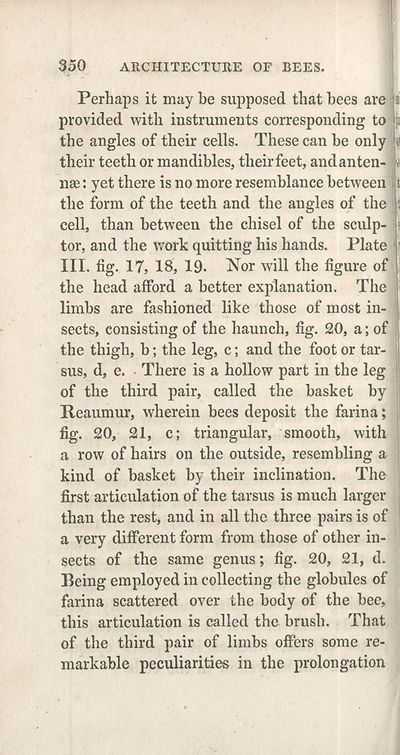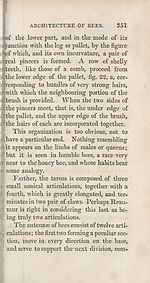Download files
Complete book:
Individual page:
Thumbnail gallery: Grid view | List view

350 ARCHITECTURE OF BEES.
Perhaps it may be supposed that bees are li
provided with instruments corresponding to m
the angles of their cells. These can he only p
their teeth or mandibles, their feet, andanten- k
nse: yet there is no more resemblance between It
the form of the teeth and the angles of the |t
cell, than between the chisel of the sculp¬
tor, and the work quitting his hands. Plate j
III. fig. 17, 18, 19. Nor will the figure of
the head afford a better explanation. The j
limbs are fashioned like those of most in- j
sects, consisting of the haunch, fig. 20, a; of |
the thigh, b; the leg, c; and the foot or tar¬
sus, d, e. There is a hollow part in the leg
of the third pair, called the basket by
Reaumur, wherein bees deposit the farina;
fig. 20, 21, c; triangular, smooth, with
a row of hairs on the outside, resembling a
kind of basket by their inclination. The
first articulation of the tarsus is much larger j
than the rest, and in all the three pairs is of 1
a very different form from those of other in¬
sects of the same genus; fig. 20, 21, d.
Being employed in collecting the globules of
farina scattered over the body of the bee,
this articulation is called the brush. That
of the third pair of limbs offers some re¬
markable peculiarities in the prolongation
Perhaps it may be supposed that bees are li
provided with instruments corresponding to m
the angles of their cells. These can he only p
their teeth or mandibles, their feet, andanten- k
nse: yet there is no more resemblance between It
the form of the teeth and the angles of the |t
cell, than between the chisel of the sculp¬
tor, and the work quitting his hands. Plate j
III. fig. 17, 18, 19. Nor will the figure of
the head afford a better explanation. The j
limbs are fashioned like those of most in- j
sects, consisting of the haunch, fig. 20, a; of |
the thigh, b; the leg, c; and the foot or tar¬
sus, d, e. There is a hollow part in the leg
of the third pair, called the basket by
Reaumur, wherein bees deposit the farina;
fig. 20, 21, c; triangular, smooth, with
a row of hairs on the outside, resembling a
kind of basket by their inclination. The
first articulation of the tarsus is much larger j
than the rest, and in all the three pairs is of 1
a very different form from those of other in¬
sects of the same genus; fig. 20, 21, d.
Being employed in collecting the globules of
farina scattered over the body of the bee,
this articulation is called the brush. That
of the third pair of limbs offers some re¬
markable peculiarities in the prolongation
Set display mode to:
![]() Universal Viewer |
Universal Viewer | ![]() Mirador |
Large image | Transcription
Mirador |
Large image | Transcription
| Antiquarian books of Scotland > Curiosities & wonders > New observations on the natural history of bees > (376) |
|---|
| Permanent URL | https://digital.nls.uk/128810379 |
|---|
| Description | Thousands of printed books from the Antiquarian Books of Scotland collection which dates from 1641 to the 1980s. The collection consists of 14,800 books which were published in Scotland or have a Scottish connection, e.g. through the author, printer or owner. Subjects covered include sport, education, diseases, adventure, occupations, Jacobites, politics and religion. Among the 29 languages represented are English, Gaelic, Italian, French, Russian and Swedish. |
|---|

